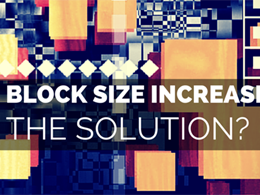
BitPay Block Size Solution Introduces Dynamic Scalability
Chinese miners would not need to worry about explosive block size growth either, as the maximum rate of growth is capped at twice the previous size. There will be no jumps from 1MB blocks to 2MB blocks and then suddenly increasing to 8 MB. This should give the local Internet infrastructure enough time to ramp up the overall network speed and [try to] get rid of data caps. For those people looking to see the Bitcoin block size debate coming to an end, that will not be happening anytime soon, unfortunately. Things have gotten more interesting a few weeks ago when rumours....
Related News
Based on block size voting results, only 27.94% of the community is in favor of the Bitcoin Core solution. The Bitcoin ecosystem is divided into multiple camps. With the lingering scalability issues, and other proposals representing an immediate solution to this problem, there is an interesting mid shift taking place. As it turns out, the majority of miners is still supporting Bitcoin Core in the block size debate. But they are losing ground at a rapid pace. Right now, there are different proposals on the table to solve the Bitcoin scalability issue. One thing everyone seems to agree on is....
Valery Vavilov, CEO of Bitfury, believes there is a solution to the current bitcoin block size challenge. In a recent video interview at TC Davos, he explained his solution and he also expounded on his belief in the future of bitcoin, taking issue with those who are proclaiming its demise. The solution to bitcoin’s block size challenge is to increase the current one-megabyte “block” to two megabytes, Vavilov said. He acknowledges the need to increase the bitcoin blockchain’s scalability, and he envisions a great future for bitcoin in improving its scalability. He gave his insights during....
There has been an ongoing Bitcoin block size debate, and most recently a radical, old idea resurfaced: instead of increasing the block size from 1MB to 2,4 or 8MB, the protocol should be changed to accommodate 32MB blocks. This probably pissed off Bram Cohen. Are 32MB Blocks Too Big? Here’s why that’s not a radical idea: it’s how Satoshi Nakamoto, creator of Bitcoin, for a time had designed Bitcoin before settling on a 1MB transaction size — a decision which, perhaps, led to Bitcoin being christened “digital gold.” Calls for large block sizes are not so uncommon: Gavin Andresen himself....
The debate to increase the bitcoin block size from its current 1MB has been going on for quite some time now. Those who are calling for a larger limit say that the current size of the network can no longer handle the transactions efficiently with such a small block size. Some say that it should be increased to 20MB while others think that 8MB would suffice. According to lead bitcoin developer Gavin Andresen, the best solution to the limited transactions of the bitcoin network is to increase the maximum block size. He even pointed out that if solution isn't implemented right away, the....
Support for BIP 100, the market-led scalability fix from core developer Jeff Garzik, is growing as more miners pick sides in bitcoin's block size debate. Data from BlockTrail indicates the percentage of blocks mined in support of BIP 100 has quadrupled to 22% following the backing of bitcoin's biggest mining pool DiscusFish / F2Pool on Monday night. Miners have the ability to voice their preference for which proposal they support, be it BIP 100 or an 8MB increase, when they 'tag' each block they mine. Unlike votes for controversial bitcoin client XT, these tags will not trigger a hard fork....





